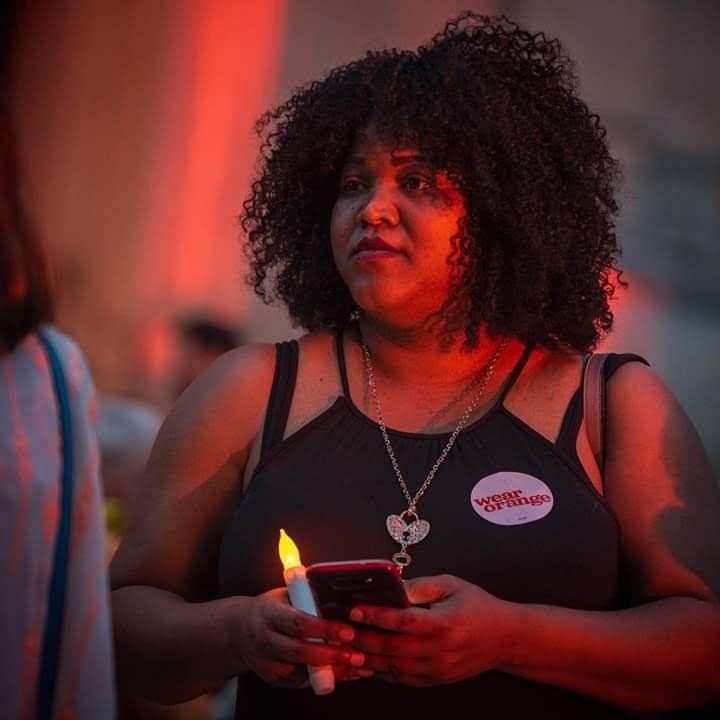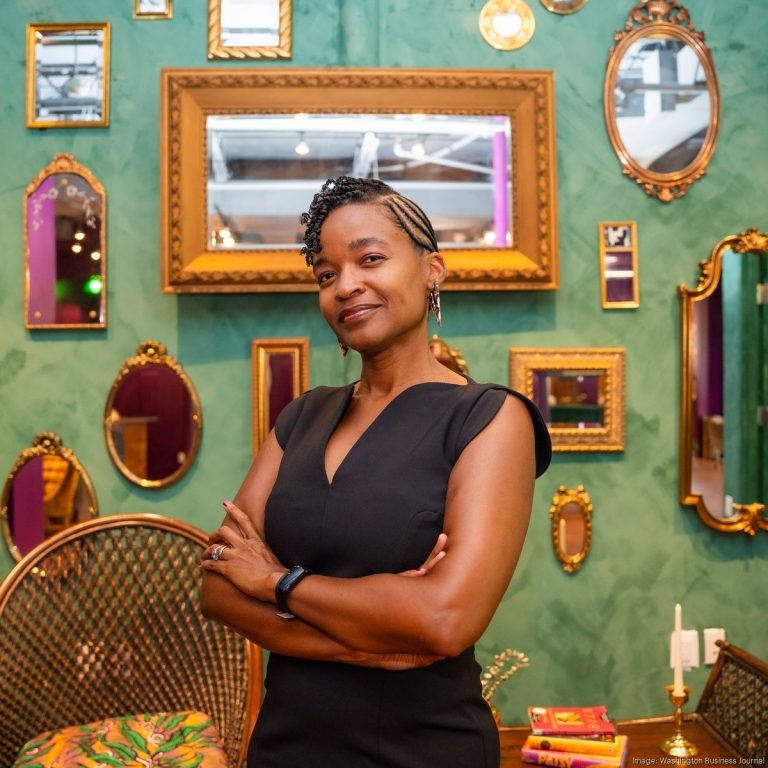Across Washington, DC, residents face extraordinary challenges. Yet DC natives hold their own solutions. Local leaders who understand both the pain and potential for healing make daily impact.
Gun violence is merely a symptom of a larger epidemic. Saving lives requires robust funding of community-based gun violence prevention and Community Violence Intervention (CVI) programs. Two remarkable organizations—the TraRon Center and the National Association for Returning Citizens (NAARC)—demonstrate the transformative power of community-led solutions.
Ryane Nickens, Founder of TraRon Center at an event for Gun Violence Awareness Month.
The Prevention Imperative: Starting Where Hope Lives
Ryane Nickens was 15 when her sister Tracy was killed by their next-door neighbor. At 17, she lost her brother Ronnie to a friend's gun. These devastating losses left her clinically depressed and struggling to trust.
Ryane left DC for college in North Carolina, seeking space to heal. During her senior year, when another close friend fell to gun violence, she felt called to return home. She enrolled in Howard University's School of Divinity and began working with the Washington Interfaith Network on gun violence prevention outreach in Wards 7 & 8.
"Meeting with community members -- including mothers of victims to gun violence -- was a powerful experience for me," Ryane shares. "I saw in them the same pain and lived experience that I had gone through."
Ryane realized what policymakers were overlooking: the need to create healing spaces for community members impacted by gun violence, especially in Wards 7 & 8.
A 2020 DC Health Matters Collaborative study found that nearly 1 in 4 residents in Ward 8 struggle with poor mental health—a tenuous situation where lack of mental health access overlaps with communities marked by gun violence.
"Our community doesn't have a safe space to process and cope with trauma," Ryane shares, recalling how she would ride the bus for nearly an hour to reach the nearest therapist as a teenager. "Our community needs somewhere that they can process their emotions; their trauma and heal in place."
Building Sacred Spaces for Healing
In 2017, Ryane started the TraRon Center—named after her siblings—as a safe space where children ages 4-14 and their families can acknowledge pain, process trauma, and learn therapeutic skills to navigate complex emotions.
"I want our children to achieve their hopes and dreams. We need to start by helping them process the trauma and pain that is holding them down," Ryane shares.
Each child takes an Adverse Childhood Experiences Study or ACES—a nationally recognized trauma assessment. Almost everyone registers scores indicating severe or significant trauma.
"We want these children to thrive," Ryane shares. "Their joy and quality of life is our long-term goal, as an organization."
Beyond therapeutic treatment, the TraRon Center provides educational opportunities including museum trips, embassy cultural center visits, and team-building summer camps. "We teach them that they are global citizens," Ryane explains, expanding their sense of possibility.
Ryane's program succeeds through authenticity. She understands violence not as abstract policy but as lived experience, channeling personal trauma into preventive healing. This creates trust outside organizations cannot establish. "Once you have their attention and they know they're in a truly safe space, you can start to unravel the causes of their trauma an begin exposing them to not just trauma informed treatments but open their minds to the beauty around them and inside of them," Ryane observes.
Since 2018, the TraRon Center has engaged over 150 children and achieved significant improvements in participants' ACES scores as youth move from surviving to thriving. These youth have gone on to become volunteers and advocates for the TraRon Center – extending the cycle of healing for those that need it.
"We want our kids headed to college, to the workforce, working towards something greater and making generational changes in community and family," Nickens says.
Intervention That Works
Eric Weaver, Founder of the National Association for the Advancement of Returning Citizens (NAARC).
Eric Weaver's journey exemplifies the transformative power of second chances. While incarcerated, Eric earned his GED and degree, led self-help groups, and tutored peers, establishing support networks to prepare people for post-release life.
"When I got out, a lot of people were asking why I wasn't doing the same things I was doing inside," Weaver recalls. How could he continue the transformative mentoring and education work outside of the prison walls?
The answer came through Peaceaholics, one of DC's earliest community violence intervention programs started in 2004. Eric began teaching GED classes and running programs. His credibility was unquestioned—when he arrived to take program participants to class, "every time, they got in the car. They needed someone who understood."
However, the initiative's impact was short-lived. Following a mayoral administration change in 2010, funding and public support for Peaceaholics quickly dried up. The results were devastating: "Everybody that was in the GED class, every last one of them is dead or locked up. That's what happened when the program stopped."
Building Credible Community Intervention
This tragedy crystallized Weaver's understanding: consistency matters in violence intervention work. In 2010, he founded the National Association for the Advancement of Returning Citizens (NAARC). In 2018, when the DC Office of the Attorney General introduced Cure the Streets—a Community Violence Intervention model proven in metropolitan cities—many in the community resisted due it’s connection to cities outside of DC. Where others saw invasion, Weaver saw opportunity. NAARC was among the first to pilot the program.
For many violence intervention workers—eighty percent of whom are returning citizens—this represents their first real post-incarceration opportunity. "Where other career opportunities look at their background as a burden, here it makes them credible in the neighborhood," Weaver notes. Cure the Streets intervention experts receive signature neon yellow uniforms and training to stop violence before it happens.
"This work saves them and helps them get on their feet, but this job also is a public safety initiative," Weaver explains. "Had these people not been able to get this job, they could have been a victim or a predator of violence."
Weaver has watched workers graduate to college and move into DC government positions. The organization includes professional development because "we don't want violence intervention workers to make a career out of it—we work with them to find the next step in life."
Beyond Crisis: Expanding Possibilities
Weaver's genius lies in understanding that intervention means more than stopping fights or retaliation—it means expanding possibilities. Beyond intervention, he has organized etiquette classes, purchased suits for youth, and provided new experiences and opportunities for those that have not been afforded to them.
"It expands a person's range; it expands their dreams," Weaver reflects. "When you give them the opportunity to explore other opportunities and see that anything is possible, they start trying to do more."
Yet like the TraRon Center, NAARC faces the fear of funding instability. DC has a pattern: violence prevention and intervention funding follows political cycles rather than community needs. Programs start with fanfare, build relationships and trust, show results—then vanish when administrations change.
"Our work is 100% based on trust," Weaver explains. "Our community trusts that no matter what happens, we'll do whatever it takes to show up for them. We need our elected officials to do the same."
A Call to Action
DC stands at a crossroads. We can continue the expensive cycle of responding to violence after it occurs—through emergency rooms, courts, and prisons—or we can invest in community-based solutions that address root causes and build lasting peace.
As Nickens puts it: "We know that our community faces obstacles beyond their control. We want to love them through it, while giving them the tools to plow through the obstacles and reach their dreams -- no matter how impossible they may seem."
Funding community-based gun violence prevention and intervention isn't just about public safety—it's about justice, dignity, and recognizing that every person deserves the chance to thrive rather than merely survive.
The question isn't whether we can afford to fund these programs. The question is whether we can afford not to.
















































































